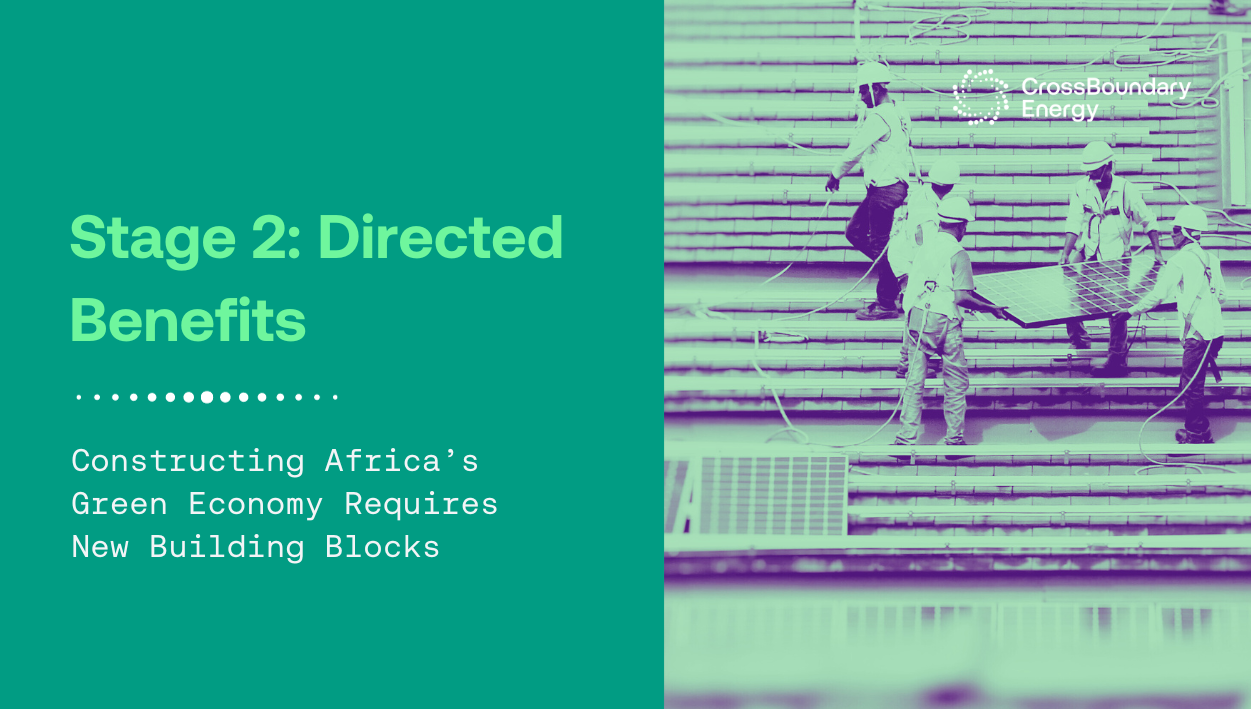
Stage 2: Directed Benefits – Constructing Africa’s Green Economy Requires New Building Blocks
As outlined in our introduction of this series, Constructing Africa’s Green Economy Requires New Building Blocks, CrossBoundary Energy is sharing an Africa-centric framework for regulators and energy sector leaders to examine each other’s experiences of integrating distributed energy resources (DER) into a future-facing energy sector. We’ve organized this into stages of DER policy evolution to provide a view of the options available to energy sector leaders and utilities. We feel these stages form the basis of new strategies to integrate DERs into electricity markets.
Previously, we discussed Stage 0: Centralized Control and Stage 1: Cautious Co-existence. In this section, we explore Stage 2: Directed Benefits. In the final part, we will share Stage 3: Early Market Management.

Stage 2: Directed Benefits
Definition of this Stage
At this Stage, a DER market is taking shape. The policy mechanisms that start to emerge rely on the State and regulators collecting and disseminating robust and accurate sector data. This wealth of technical information, when afforded to DER providers, enables the State to step back and allow the nascent market to direct DER benefits.
The NREL paper we’ve quoted previously in this series named this Stage “Market Creation.” We instead use the title “Directed Benefits” as it speaks more directly to how policymakers are correctly identifying the potential gains of DERs, but still controlling how those benefits are directed. Capacity thresholds or mandates are adopted which set upper limits on total DER generation. Where interconnection to the national grid is permitted, the national utilities dictate where, when, and at what cost, this work can be undertaken. Regulatory opening yes—but also strict procedures to be followed.
In addition to addressing new complexity presented by DERs, at this Stage policymakers also gain an understanding of how DERs can fit into the wider energy landscape. They learn how DERs can productively coexist with centralized utilities. Enabling the wheeling of power from DERs to businesses through the network, can unlock revenue for owners of grid infrastructure. Through the use of system costs, utilities can directly benefit from the increased deployment of DERs. Further benefits of DER integration like contribution to grid stability, reduced overall energy costs, and provision of surplus power become clearer and can be proven from sector data.
Utilities and regulators gain experience of how to mitigate the risk of overloading distribution networks, should injected DER capacity overwhelm technical limits. Greater penetration of variable generation from DERs requires the electricity system to become more flexible. We wrote in Stage 1 about one of the benefits of DERs being minimal grid impact at lower levels of penetration. At higher levels of penetration, and once larger DER projects are operating on the network, new complexity is introduced. It becomes imperative that the grid is effectively managed. Spinning reserve and additional dispatchable generation capacity on the grid is needed to smooth the fluctuations of intermittent renewable energy from DERs. This should be a core focus of utility leaders at this Stage.
Through the publication of sector data by energy regulators, the market starts responding and collectively proposing amendments to the rules that govern their activities. The private sector is acting with increased alignment and coordination. Transparent information about market activity enables a truly even playing field.
Selected case studies for this stage
South Africa
The first market in Africa that we would consider to be entering Stage 2. In 2022 a competent and technical energy sector regulator, NERSA, lifted the licensing threshold for DERs in response to the generation shortfall – estimated by the national utility, ESKOM, to be 6GW—and persistent need for nation-wide ‘loadshedding’. Due to these important regulatory changes, DER providers now enjoy streamlined licensing timelines for new projects. While these moves are noteworthy, these licensing improvements are largely work for Stage 1. What marks South Africa as fit for Stage 2 is perhaps more mundane but no less important. It is the way data is being used to drive further integration and penetration of DERs.
One example is how the national utility ESKOM is making available grid capacity data and routinely publishing updates on grid integration interconnection queues. The private sector is, in turn, trusted to make informed decisions on where to deploy new projects based on this data. A second example is streamlining and publication of the grid integration process to encourage further deployment of DERs. The new rules changed the process from a “first come, first served” principle to “first come, first ready”. While some IPPs challenged the new rules on the basis that long-standing projects would be adversely affected, the rules do prioritise projects that are ready to utilise capacity. In our view, demonstrated readiness constitutes a more efficient handling of the grid queuing process. Either way the publication of new rules—if uniformly applied—will support DER providers better determine project bankability by providing clearer development timelines.

Johannesburg, South Africa
Costa Rica
Looking beyond our Sub-Saharan Africa focus of this Series, Costa Rica provides an interesting example of regulatory frameworks intended to support effective deployment of DERs. A December 2022 paper by the US National Association of Regulatory Utility Commissioners, NARUC, highlights how the national energy regulator, ARESEP, is using a data-driven approach for deployment of DERs. NARUC underscored how ARESEP is focusing on developing technical instruments for calculating the penetration of DERs in the national energy system. This data is being used to: (i) apply bespoke network interconnection fees which are newly in line with total consumption and network capacity requirements; and (ii) supporting different distribution companies—the sector is unbundled—to agree with self-producers on clear rules for load limits per circuit and related network access requirements.

San José, Costa Rica
California
Another good example of how a country can progress into Stage 2. Though California has one of the most advanced markets for DERs in the world, we find examples of how its regulators use data to still be applicable to their African counterparts. For a number of years, the State utility has made available distribution system ‘heat maps’ which provide important data to inform DER integration including line voltage, load, and interconnected as well as queued generation capacity. In 2016 the State also hosted a series of workshops called ‘integration capacity (ICA) proceedings’. During the ICA proceedings engineers from three private utilities worked with DER providers to develop a shared framework for DER connection to California’s distribution networks. A dedicated public-private working group was established to identify capacity limits for DER integration at different interconnection points. A second working group focused on bringing DER-provider perspectives into the annual planning of the State’s privately-run utilities. The discussion points from the ICA workshops and working group meetings were made publicly available in a joint final report, allowing full-sector alignment around key issues facing DER providers in the State. As a result of the collaborative and data-backed discourse, and to effectively address network management, DER providers agreed to new requirements in 2017 that all DERs applying for new interconnection must be fitted with ‘smart inverters’ to provide basic grid support functions.

Sacramento-San Joaquin Delta, California
Recommendations for policymakers and regulators
As our case study examples demonstrate, what is important at this “Directed Benefits” Stage is the use of sophisticated sector and network data to update existing regulatory frameworks for the integration of DERs. Utilities must lead this charge by developing a robust baseline understanding of their grid, largely through the collection of data that provides near real-time insights on the grid hosting capacity, customer demand, and end-use energy behind it.
To move into the next Stage—a fully-fledged wholesale electricity market with flexible market management mechanisms—utilities and regulators must leverage the data available to allow DERs to be deployed in the agile and stable configurations which optimize load distribution and ensure effective grid management. Trust-based collaboration must then be established between DER providers and utilities such that they can respond to this call.
In Africa, several utilities are already embracing technologies that support such data-gathering. One example is Somalia, where Power Africa has been working since 2022 to pilot SparkMeter’s technology on the 20,000-customer national distribution network. Grid monitors, placed at strategic points on the network, helped the national utility to compare readings with reported energy consumption of customers on their network. This allowed the utility to view losses in near real-time on the network. As part of a commercial roll-out of the smart meter technology, Somalia’s national utility, NECSOM, could be extended to help assess network capacity challenges or to support optimisation of potentially cheaper renewable energy solutions, including DERs.
Building on these digital innovations, at this Stage African utilities and regulators must work closely with DER providers to understand exactly which data would be most relevant and useful—as California did through their ICA proceedings in 2016-17. Regulators must then make this data publicly available on a level-playing field basis to support more informed DER investment decisions. As in the case of California, providers can be mandated to fit smart grid technologies, for example smart inverters, to support grid management.
Next, regulators should look for ways to make regulatory improvements based on the decisions taken by DER providers newly armed with timely, technical data. Lessons can be learned from how Costa Rica is developing bespoke interconnection fees to incentivize DER providers to interconnect in underserved regions of the network. Providers looking to maximize project returns may opt for acquiring land and developing plants closest to the cheapest interconnection points.
Other applications for data-driven regulation might include net metering or energy wheeling. Under both frameworks, DERs are invited to play a more formal role in the electricity network by supplying surplus electricity from self-production back into the network. Net-metering credits and benefits can, for example, be reflective of grid capacity constraints to adequately incentivize providers to focus on these parts of the electricity network. Wheeling projects can similarly provide differentiated credits to customers using wheeled distributed energy based on time of use.
These kinds of pricing signals can efficiently be used to encourage DER grid injection based on when it is most needed (based on peak consumption) and where intermittency challenges must be most closely managed. Energy sector leaders would be using data-driven collaboration and transparency to allow for more flexible market management. They would be positioning the market to fully reap DER benefits and establish the foundation for market management.
In the next installment of this series, Constructing Africa’s Green Economy Requires New Building Blocks, we will break down Stage 3: Early Market Management.





